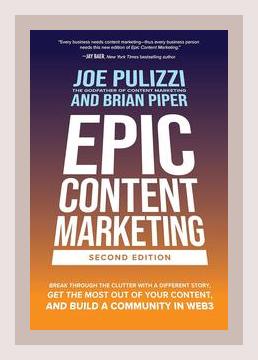Marketing and SalesDigital MarketingContent MarketingAdvertising
**
Introduction: Understanding Epic Content Marketing
“Epic Content Marketing” by Joe Pulizzi, published in 2013, is a comprehensive guide that demonstrates how businesses can develop a long-term content marketing strategy to attract and retain customers. Pulizzi’s core premise is that companies should act more like publishers and less like traditional marketers to create content that is engaging, targeted, and valuable. This groundbreaking concept provides a roadmap for businesses to build loyal audiences that convert into customers through high-quality, relevant, and consistent content.
Chapter 1: The Age of Content
Major Point: Transition from Traditional Marketing to Content Marketing
Pulizzi begins by discussing the shift from traditional advertising methods to more valuable and engaging content marketing approaches. Traditional marketing is often interruptive and its efficacy has dwindled over time due to audience aversion to ads.
Concrete Example: John Deere’s The Furrow magazine.
John Deere took a pioneering role in content marketing by publishing The Furrow magazine, which offers farming tips instead of directly selling products.
Actionable Step: Evaluate current marketing strategies and reduce reliance on overt advertisements. Begin focusing on the creation of valuable content that addresses the needs and interests of your audience.
Chapter 2: Defining Your Niche
Major Point: Importance of Focusing on a Niche Audience
Pulizzi emphasizes the significance of targeting a smaller, specific audience instead of a broad one.
Concrete Example: Red Bull’s extreme sports content.
Red Bull doesn’t just market its energy drinks; it produces content around extreme sports, targeting adrenaline junkies.
Actionable Step: Identify your niche audience by understanding their specific needs and interests. Create content tailored specifically to this group to build a more engaged community.
Chapter 3: The Content Inc. Model
Major Point: Building a Foundation with the Content Inc. Model
Pulizzi presents the Content Inc. model, which includes seven steps: Sweet Spot, Content Tilt, Building the Base, Harvesting the Audience, Diversification, Monetization, and The Content Inc. Empire.
Concrete Example: Geek & Sundry’s focus on geek culture.
Geek & Sundry, a multimedia production company, built a content empire by focusing on niche geek culture and diversifying its content across various platforms.
Actionable Step: Develop a roadmap based on the Content Inc. model. Start by identifying your ‘Sweet Spot’ (intersection of knowledge and passion) and work towards building a diversified content strategy.
Chapter 4: Creating Valuable Content
Major Point: Quality Over Quantity
Pulizzi highlights the need for quality content that provides real value to the audience. It should solve problems, inform, or entertain.
Concrete Example: American Express’s OPEN Forum.
American Express created OPEN Forum to provide business advice and solutions, thus becoming a valuable resource for small business owners.
Actionable Step: Focus on creating high-quality content that addresses the pain points of your audience. Develop a content calendar to ensure regular and consistent publishing without compromising quality.
Chapter 5: Building the Base
Major Point: Consistency and Patience
Building a loyal audience requires patience and consistent content delivery.
Concrete Example: Moz Blog’s gradual rise to authority.
Moz, an SEO software company, consistently published valuable blog posts and gradually became an authority in the digital marketing space.
Actionable Step: Maintain a consistent publishing schedule. Use content management systems to plan and automate postings to ensure regularity.
Chapter 6: Harvesting the Audience
Major Point: Developing Subscriber Relationships
Pulizzi stresses the importance of converting one-time visitors into regular subscribers.
Concrete Example: HubSpot’s use of gated content.
HubSpot offers comprehensive guides and templates in exchange for user information, thus growing its subscriber base substantially.
Actionable Step: Create lead magnets such as eBooks, whitepapers, or exclusive webinars to encourage visitors to provide their contact information and subscribe to your content.
Chapter 7: Diversification
Major Point: Multi-Platform Content Strategy
Pulizzi advises distributing content across multiple platforms to reach a broader yet targeted audience.
Concrete Example: Coca-Cola’s content diversification.
Coca-Cola uses various platforms from YouTube to Instagram to feature engaging content like behind-the-scenes videos and interactive posts.
Actionable Step: Repurpose content across different platforms. Turn a blog post into a video, slide presentation, or social media post to maximize reach and engagement.
Chapter 8: Content Monetization
Major Point: Turning Content into Revenue
Pulizzi provides insights into how effective content marketing can lead to monetization through various streams.
Concrete Example: Copyblogger’s multi-revenue model.
Copyblogger monetizes its content through premium memberships, courses, and software sales.
Actionable Step: Explore different monetization strategies such as direct sales, subscriptions, affiliate marketing, and sponsored content. Evaluate which models align best with your business objectives and audience.
Chapter 9: Measuring Success
Major Point: Importance of Analytics
Effective content marketing strategies are always backed by data and analytics. Understanding what content performs best helps refine future strategies.
Concrete Example: Analyzing Patagonia’s environmental campaigns.
Patagonia uses analytics to gauge the impact of its environmental content and adjust strategies accordingly to further engage its audience.
Actionable Step: Implement analytics tools such as Google Analytics, HubSpot, or custom dashboards. Regularly review and analyze metrics like page views, engagement rates, and conversion rates to inform future content strategies.
Chapter 10: The Future of Content Marketing
Major Point: Evolving with Trends and Technology
Pulizzi concludes with the notion that content marketing is ever-evolving, and businesses must stay ahead of trends and technological advancements.
Concrete Example: The rise of VR in content marketing.
Pulizzi discusses how virtual reality (VR) could revolutionize the way companies engage with their audience, offering immersive experiences.
Actionable Step: Stay updated with industry trends and emerging technologies. Experiment with new content formats like VR, interactive content, or AI-driven personalization to keep your audience engaged.
Conclusion: Embarking on Your Content Marketing Journey
Joe Pulizzi’s “Epic Content Marketing” is a detailed guide that encourages companies to think like publishers. Following its principles, businesses can create compelling content that not only attracts but retains and converts customers. By focusing on quality, consistency, diversification, analytics, and future trends, companies can build a formidable content marketing strategy that drives long-term business growth.
Marketing and SalesDigital MarketingContent MarketingAdvertising
